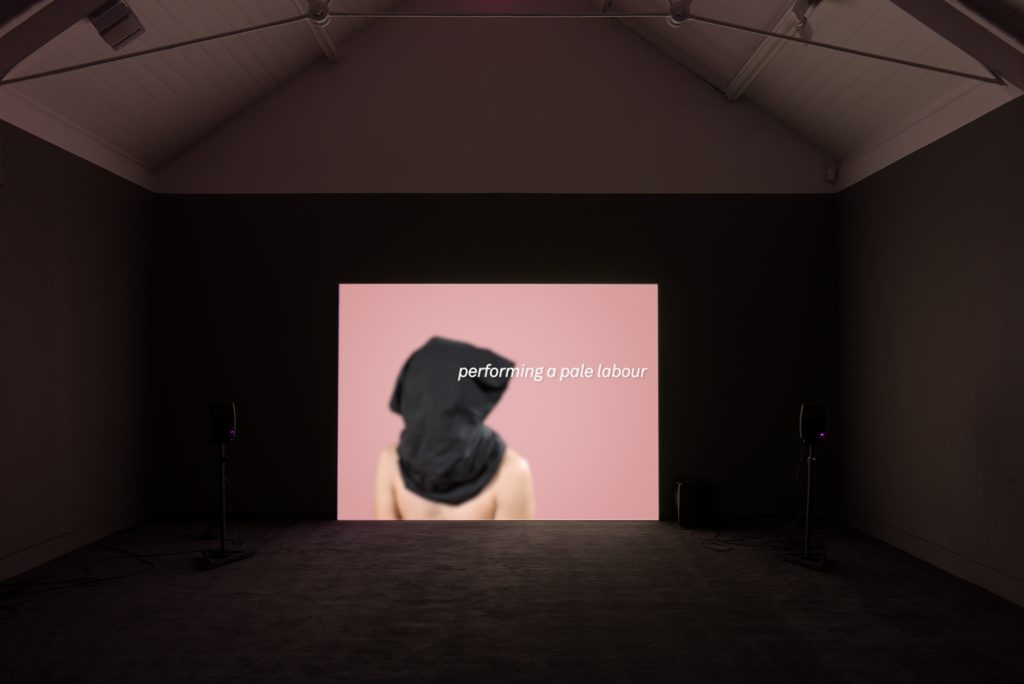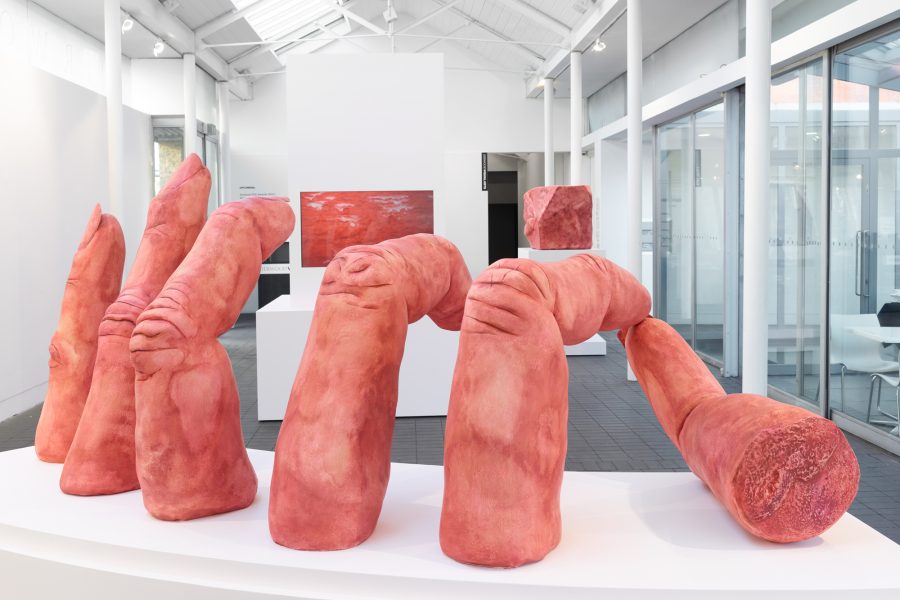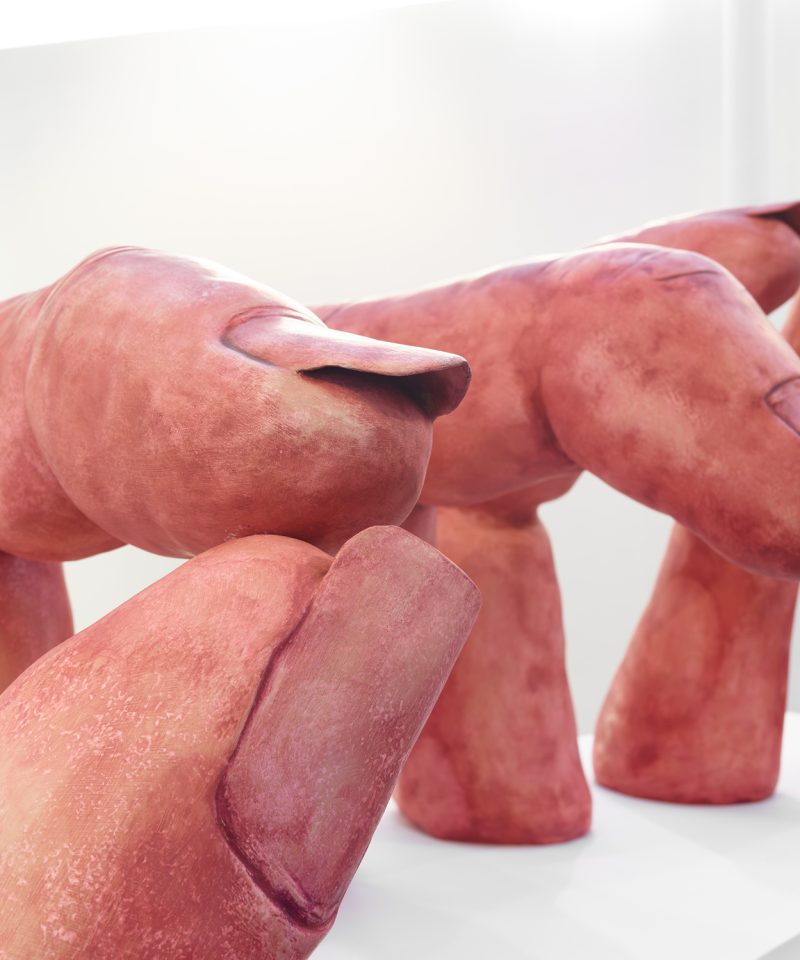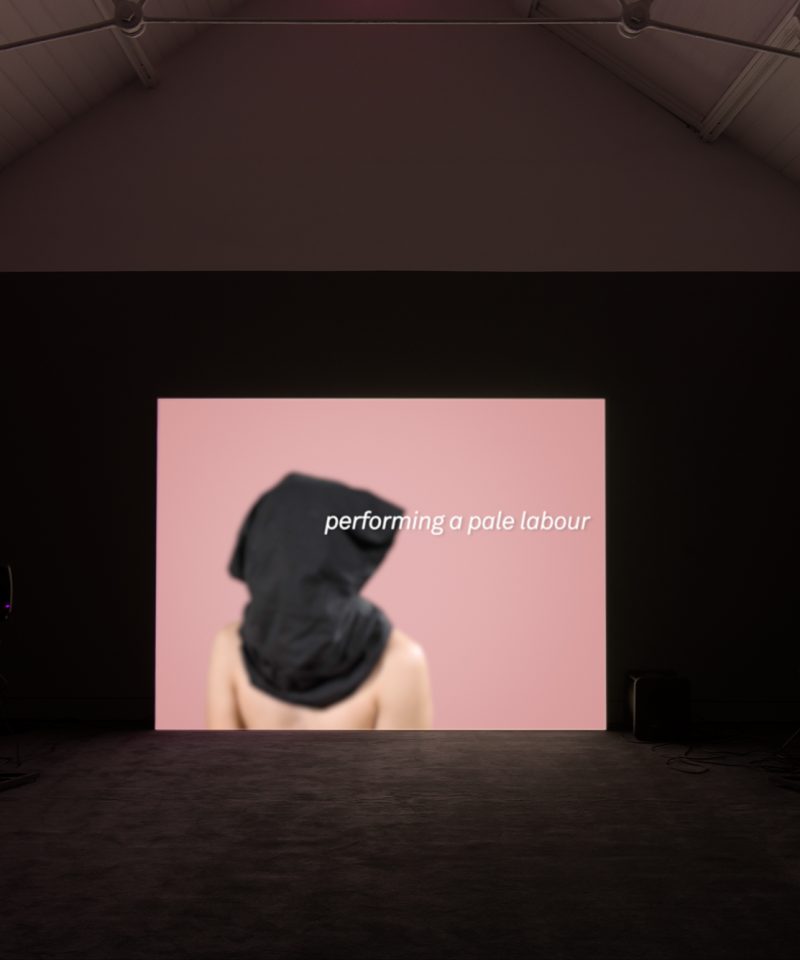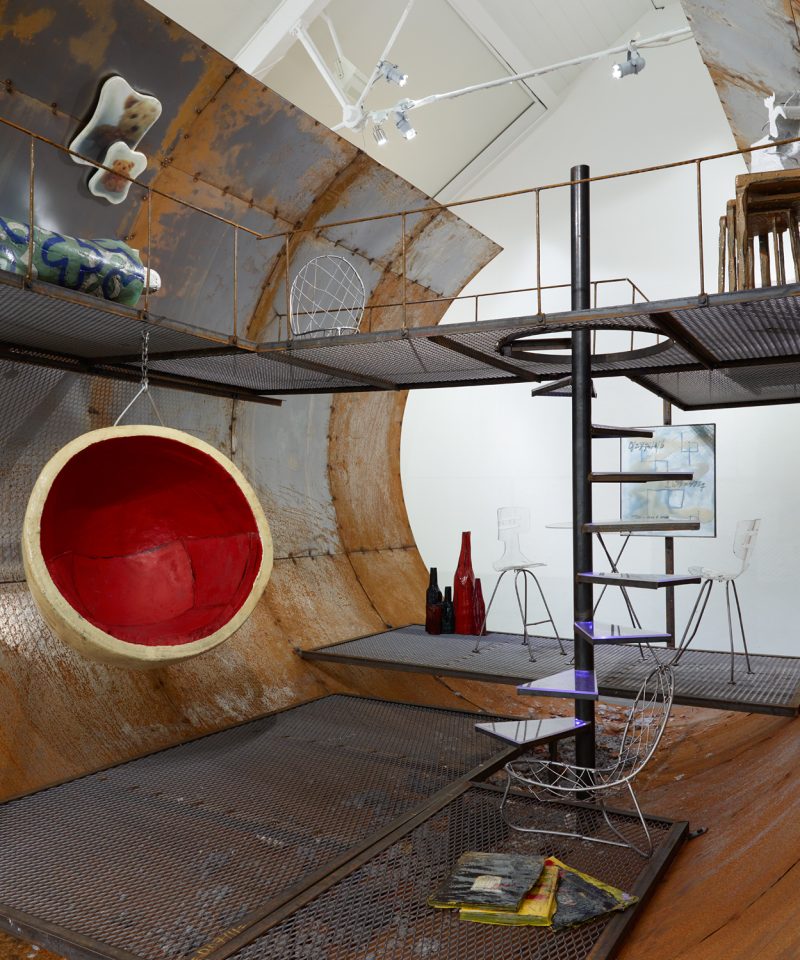Imran Perretta’s single channel film installation, brother to brother (2017), presents the sovereign gaze of Power in two distinct modes. One is reactive, stationary and disciplinary, the other proactive, mobile and predatory. The egress from one to the other – these modes are spatially construed – is experienced as a disorientating interior/exterior slip, an unexpected woozy interim of free-fall. It could be compared to sudden cabin pressure loss on a plane or – to use a musical corollary appropriate to Imran’s other practice as a DJ – a bass drop. Whatever analogy fits, the shift is one of some fixed structure coming free from its moorings.
The first principal space is a starkly lit, almost entirely de-saturated, green room. The artist looks vulnerable and afraid in this room, perched on a tiny stool, naked except for a hood over his head. There’s an ominous droning punctuated by sporadic noises corresponding to small disruptions in the otherwise fixed shot. This is the space of detention, interrogation, and close observation. The central role of optical experience in social domination has been theorised enough not to warrant much further space here, but it does underscore the constitution of this space significantly. It can be said, in some sense then, to be a Foucauldian space – a space where “‘subjects’ (are) presented as ‘objects’ to the observation of a power that (is) manifested only by its gaze.’ (Foucault, Discipline and Punish)
The resemblance of the green room sequence to the images of detainee abuse in the Abu Ghraib prison is stark and harrowing. That scandal came to light at what was probably a formative age for Imran. His adolescence would have been almost concurrent with two terms of George W. Bush’s US presidency. At this time, bodies of Middle Eastern or South Asian identity were manifest in the circulating network of mass media images chiefly as a sign of alarm. Construed as modern day berserkers when engaged in conflict, deeply suspect when at peace, just about tolerable in a state of gross humiliation. Granted, there was public disapproval surrounding Abu Ghraib, but the effect was not as toxic to the administration as one might have expected. An art historical account for this was given by Stephen S. Eisenman in The Abu Ghraib Effect. Eisenman – who found public opinion on the outrage disturbingly sedate – referred to the Pathos Formula (Pathosformel) of art historiographer Aby Warburg to account for the ease with which the documentation had become assimilated into a collective reserve of sorts: a standard visual lexicon of conflict stock imagery.
In light of this analysis Imran’s body is almost disturbingly statuesque, but art history makes no account for lived experience. It’s worth noting, here, that the film is partly the artist’s reflection on his personal experience of being searched by a customs officer at a London airport on returning home from Bangladesh. Like Imran, the officer was a man of South Asian descent, which was felt as a profound dissonance, a treacherous intersection of sociopolitical conditions that led to this dispiriting moment.
The second space we drop into, again, intermittently features the hooded figure of the artist, now in soft focus, superimposed against a backdrop of drone footage with a poetic text overlaid. In the drone space the imagery is more restless – disrupted and disruptive. Its disruptiveness arises from an intrinsic friction between the panoramic scope of the footage and its conversely claustrophobic affect – the drone sensorium is not liberating. The interrogation room looked more spacious. That we have already seen Imran detained, incapacitated in a green room with studio lighting likely prompts us to experience anything he’s set against as a second artifice within the first. The drone footage here is lifted from tourist material but of manifest military provenance in its functioning as a visual apparatus.
The military strategy of dispatching explosives via unmanned vehicles can be traced as far as the mid-nineteenth century at least, but drone technology tends to be thought of as a recent shift in the perspectival constitution of power – one yet to be subject to a comprehensive analysis. Inasmuch as it represents a geopolitically specific perspective liberated from its locality, the disembodied and weaponised eye has an extensive pre-history, through Euclidean optics, in the renaissance development of linear perspective. This movement has been persuasively articulated by Victor Burgin in the essay Geometry and Abjection. He notes that ‘a basic principle of Euclidean geometry is that space extends infinitely in three dimensions. The effect of monocular perspective, however, is to maintain the idea that this space does nevertheless have a centre – the observer.’ Linear perspective makes the observer – equal and opposite to the vanishing point – a sort of spatial autarch, a receptacle of the visual world upon whom all orthogonals converge and thus, from whom, no worldly access may be withheld – ‘the ocular subject of perspective, and of mercantile capitalism… free to pursue its entrepreneurial ambitions wherever trade winds blow.’ Victor Burgin. Geometry and Abjection, published in In/Different Spaces – Place and Memory in Visual Culture)
The abject in this film has been discussed in terms of the violence – or threat thereof – exercised by one individual over another; here we see the abject figure of the supplicant, the exercise of control or force, as Simone Weil described it ‘…that which makes a thing of whoever submits to it. Exercised to the extreme, it makes the human being a thing quite literally, that is, a dead body.’ (Simone Weil, The Iliad or The Poem of Force). Imran’s body mimics death or near-death. Overexposure blanches his skin tone, he has discussed his pallor in its allusion to sickness and shock but also to the ethnic skew in the technology of the medium – standard settings typically privilege the Caucasian.
The corpse – or the corpse-like body, in mute rage and fear, stilling itself to be spared further sanction – often stands in as the signifier of the abject; its locus inasmuch as the abject has one. However, if we consider the abject as Julia Kristeva posited it in The Powers of Horror (1980) we also see the subtending abjection of border control itself. For Kristeva, the abject is neither subject nor object but that which jeopardizes the border between the two, undermines the sanctity of the interior, compels the subject to turn itself inside out; ‘I expel myself, I spit myself, I abject myself within the same motion through which “I” claim to establish myself.’ The abject, by its mere existence, provokes a violent compulsion to reassert sovereignty and interiority but evacuates something of itself in the process. The supra-abjection in the film is not that of the individual super-ego, but the abject convulsion of the nation state that constitutes itself as an entity under threat ‘…It is thus not lack of cleanliness or health that causes abjection but what disturbs identity, system, order. What does not respect borders, positions, rules.’
Racism-as-abjection is not historically unique to the post September 11th West but intensified national security rhetoric and bellicose foreign policy statements posit it as one of the most durable ongoing public manias of the War on Terror. For much of the nineties the US was steadily menaced from within – there was a focus on the overwhelmingly white, right-libertarian militia movement and renegade religious sects. Notorious episodes of the era included sieges in Waco and Ruby Ridge and the Oklahoma City bombing. They signaled a deep, violent and abiding distrust of the federal government and, although such movements were largely on the wane by the end of the Clinton era, the War on Terror saw a dramatic and catastrophic externalisation of domestic anxieties. Terror was – and, sixteen years on, still is – abjected.
This abjection does not only compel the absolute expulsion of the foreign nor the absolute retention of the native, neither of which is possible. The shift from domestic surveillance in the institutional / architectural model of panopticism, to the global surveillance of the drone calls to mind a line from the Powers of Horror: ‘It is no longer I who expel, “I” is expelled.’ In brother to brother’s drone-space, eye is expelled – a movement that is centrifugal to it. If this focus seems a little myopic (more ocular metaphors) it should be said that the film actually has a richness of text and subtext that I may not do justice. The artist’s public conversation with Rizvana Bradley gave him the opportunity to outline the significance of sound and musicality, race, intonation, and strategies of resistance.
